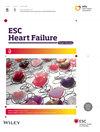Pulmonary congestion relief by adding dapagliflozin to intravenous loop diuretic in acute heart failure patients
Abstract
Aims
We aim to assess the efficacy of congestion relief and safety associated with adding SGLT2i (viz., dapagliflozin 10 mg) to intravenous loop diuretics within 24 h of hospital presentation in patients with acute heart failure (AHF).
Methods and results
A single-centre open-label clinical research study enrolled 98 patients admitted with an episode of AHF who were randomized into two groups: (a) receiving SGLT2i once daily in addition to structured intravenous furosemide therapy; (b) receiving structured intravenous furosemide therapy alone. In-hospital congestion relief was evaluated by body weight change, EVEREST score, lung ultrasound B-lines, inferior vena cava ultrasound measurement, NT-proBNP and CD146. Safety was assessed by changes in renal function and serum electrolyte abnormalities. Secondary endpoints included diuresis and natriuresis, hospital care indices and echocardiographic changes in cardiac function at 1-month. ANCOVA analysis was performed to adjust for imbalance between the two groups regarding chronic kidney disease status and baseline values. The analysis followed an intention-to-treat approach. The mean age ± standard deviation in the SGLT2i and control group was 63.63 ± 10.95 years and 65.31 ± 10.82 years, respectively, with 40/49 and 42/49 males. No death occurred in hospital; 1/49 and 2/49 deaths at 30 days were recorded. The adjusted mean change ± standard error (SE) in body weight was −4.90 ± 0.93 kg versus −4.28 ± 0.81 kg in the SGLT2i and control group, respectively. The adjusted mean change ± SE in B-lines at discharge and at 1 month was −19.93 ± 0.87 versus −18.64 ± 0.79 (P = 0.227) and −19.65 ± 1.54 versus −14.82 ± 1.43 (P = 0.012), respectively. The proportion of worsening renal function was 15/49 and 6/47 (P = 0.048) in the respective treatment groups (SGLT2i and control). The adjusted mean ± SE of 24-h urinary Na was 248.03 ± 23.69 mmol/day versus 173.83 ± 20.76 mmol/day (P = 0.009). One-month changes in ultrasound parameters were significantly improved in the SGLT2i group, with median (inter-quartile range) values of left ventricular ejection fraction and end-diastolic volume equal to 5% (0.35% to 11.5%) versus 0 (−1% to +5%) and −6.5 mL (−27.5 to +3) versus 4 mL (−11.5 to +10), respectively.
Conclusions
Early initiation of SGLT2i administration in addition to intravenous loop diuretics in patients with AHF would optimize congestion relief and improve clinical outcomes.


 求助内容:
求助内容: 应助结果提醒方式:
应助结果提醒方式:


